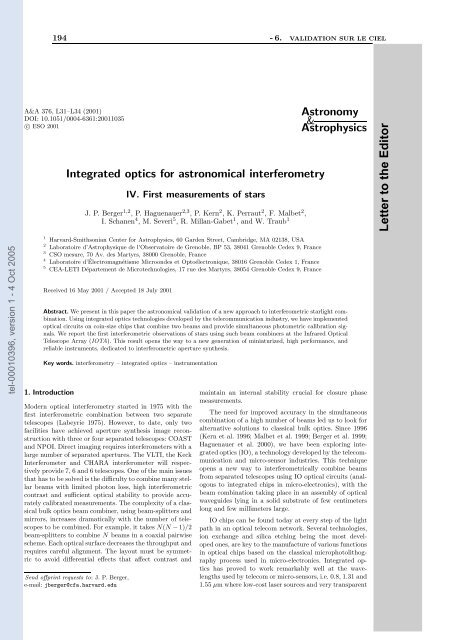Qualification de IONIC, instrument de recombinaison ...
Qualification de IONIC, instrument de recombinaison ...
Qualification de IONIC, instrument de recombinaison ...
Create successful ePaper yourself
Turn your PDF publications into a flip-book with our unique Google optimized e-Paper software.
tel-00010396, version 1 - 4 Oct 2005<br />
194 - 6. VALIDATION SUR LE CIEL<br />
A&A 376, L31–L34 (2001)<br />
DOI: 10.1051/0004-6361:20011035<br />
c○ ESO 2001<br />
Integrated optics for astronomical interferometry<br />
IV. First measurements of stars<br />
J. P. Berger 1,2 , P. Haguenauer 2,3 , P. Kern 2 , K. Perraut 2 , F. Malbet 2 ,<br />
I. Schanen 4 , M. Severi 5 , R. Millan-Gabet 1 , and W. Traub 1<br />
1 Harvard-Smithsonian Center for Astrophysics, 60 Gar<strong>de</strong>n Street, Cambridge, MA 02138, USA<br />
2 Laboratoire d’Astrophysique <strong>de</strong> l’Observatoire <strong>de</strong> Grenoble, BP 53, 38041 Grenoble Ce<strong>de</strong>x 9, France<br />
3 CSO mesure, 70 Av. <strong>de</strong>s Martyrs, 38000 Grenoble, France<br />
4 Laboratoire d’Électromagnétisme Microon<strong>de</strong>s et Optoélectronique, 38016 Grenoble Ce<strong>de</strong>x 1, France<br />
5 CEA-LETI Département <strong>de</strong> Microtechnologies, 17 rue <strong>de</strong>s Martyrs, 38054 Grenoble Ce<strong>de</strong>x 9, France<br />
Received 16 May 2001 / Accepted 18 July 2001<br />
Astronomy<br />
&<br />
Astrophysics<br />
Abstract. We present in this paper the astronomical validation of a new approach to interferometric starlight combination.<br />
Using integrated optics technologies <strong>de</strong>veloped by the telecommunication industry, we have implemented<br />
optical circuits on coin-size chips that combine two beams and provi<strong>de</strong> simultaneous photometric calibration signals.<br />
We report the first interferometric observations of stars using such beam combiners at the Infrared Optical<br />
Telescope Array (IOTA). This result opens the way to a new generation of miniaturized, high performance, and<br />
reliable <strong>instrument</strong>s, <strong>de</strong>dicated to interferometric aperture synthesis.<br />
Key words. interferometry – integrated optics – <strong>instrument</strong>ation<br />
1. Introduction<br />
Mo<strong>de</strong>rn optical interferometry started in 1975 with the<br />
first interferometric combination between two separate<br />
telescopes (Labeyrie 1975). However, to date, only two<br />
facilities have achieved aperture synthesis image reconstruction<br />
with three or four separated telescopes: COAST<br />
and NPOI. Direct imaging requires interferometers with a<br />
large number of separated apertures. The VLTI, the Keck<br />
Interferometer and CHARA interferometer will respectively<br />
provi<strong>de</strong> 7, 6 and 6 telescopes. One of the main issues<br />
that has to be solved is the difficulty to combine many stellar<br />
beams with limited photon loss, high interferometric<br />
contrast and sufficient optical stability to provi<strong>de</strong> accurately<br />
calibrated measurements. The complexity of a classical<br />
bulk optics beam combiner, using beam-splitters and<br />
mirrors, increases dramatically with the number of telescopes<br />
to be combined. For example, it takes N(N − 1)/2<br />
beam-splitters to combine N beams in a coaxial pairwise<br />
scheme. Each optical surface <strong>de</strong>creases the throughput and<br />
requires careful alignment. The layout must be symmetric<br />
to avoid differential effects that affect contrast and<br />
Send offprint requests to: J. P. Berger,<br />
e-mail: jberger@cfa.harvard.edu<br />
maintain an internal stability crucial for closure phase<br />
measurements.<br />
The need for improved accuracy in the simultaneous<br />
combination of a high number of beams led us to look for<br />
alternative solutions to classical bulk optics. Since 1996<br />
(Kern et al. 1996; Malbet et al. 1999; Berger et al. 1999;<br />
Haguenauer et al. 2000), we have been exploring integrated<br />
optics (IO), a technology <strong>de</strong>veloped by the telecommunication<br />
and micro-sensor industries. This technique<br />
opens a new way to interferometrically combine beams<br />
from separated telescopes using IO optical circuits (analogous<br />
to integrated chips in micro-electronics), with the<br />
beam combination taking place in an assembly of optical<br />
wavegui<strong>de</strong>s lying in a solid substrate of few centimeters<br />
long and few millimeters large.<br />
IO chips can be found today at every step of the light<br />
path in an optical telecom network. Several technologies,<br />
ion exchange and silica etching being the most <strong>de</strong>veloped<br />
ones, are key to the manufacture of various functions<br />
in optical chips based on the classical microphotolithography<br />
process used in micro-electronics. Integrated optics<br />
has proved to work remarkably well at the wavelengths<br />
used by telecom or micro-sensors, i.e. 0.8, 1.31 and<br />
1.55 µm where low-cost laser sources and very transparent

















